The Surface 3 Review
by Brett Howse on May 4, 2015 9:00 AM ESTSystem Performance
Since the Surface 3 is a tablet that can replace your laptop, comparisons will be made between both devices. Because the new tablet is running full Windows 8.1 x64, it is possible to run the full benchmark suite that we have for laptops. On the tablet side, there are not a lot of cross-platform benchmarks so the only thing that can really be used is browser based tests. It is not ideal, but we have to work with what we have.
To summarize the Surface 3, it is powered by the top model of the latest Intel Atom 14nm stack. The Atom x7-Z8700 is a quad-core processor with a base frequency of 1.6 GHz. The CPU can turbo up to a maximum of 2.4 GHz, and all of this is done within a 2 watt Scenario Design Power. The review unit that I received is the $499 unit, so it only has 2 GB of LPDDR3 memory rather than the 4 GB offered on the higher priced model.
For comparisons against tablets, I have selected a sampling of several devices that have already been reviewed. Some of the devices are running on ARM processors, and several of the Windows ones run on Intel Core M, with a few more running on previous Atom architectures. To compare this device against any other device we have tested, please check out our Mobile Bench.
Tablet Performance
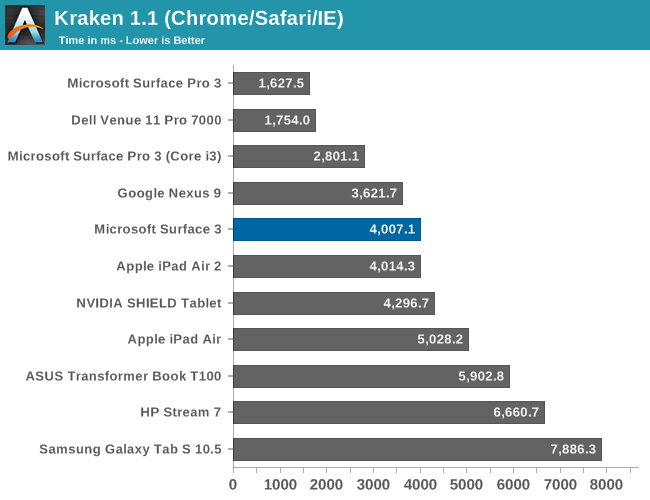
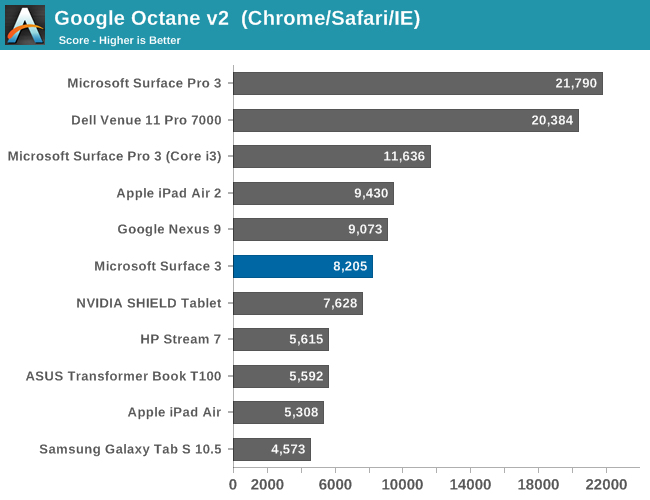

Since we just have web benchmarks to compare against other platforms, it does make it difficult to get a true feel for how Atom compares to the best, but when comparing to ARM processors it is fairly competitive. All of the web benchmarks are done using Chrome (hopefully we can switch to Microsoft Edge soon) because IE 11 has pretty awful javascript performance. Atom is a long ways off of the Core series in the Surface Pro line, and well back of the Core M powered Dell Venue 11 Pro tablet. There is a big jump in performance compared to the Bay Trail ASUS T100 and HP Stream 7. That is important since Cherry Trail is not a big architecture update, but mostly a process shrink, so the 14 nm processes can keep everything running at higher frequencies in the same power envelope.
Laptop Performance
By attaching the keyboard, the Surface 3 becomes a pretty reasonable laptop, so to see how much of a performance drop off there is with tablet class parts, the Surface 3 was run through our Laptop suite as well. The Atom is also equipped with eMMC storage, and some of the tests like PCMark take storage into account. Other benchmarks like Cinebench and x264 are CPU only. To compare the Surface 3 against any other laptop we have tested, please use our Laptop Bench.
PCMark

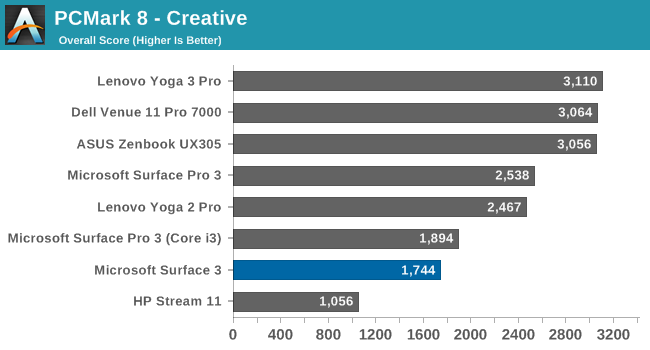
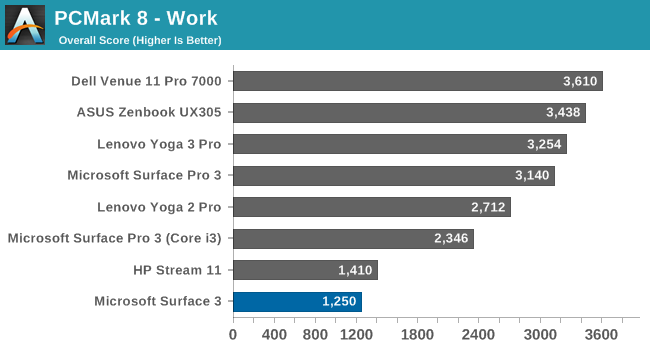
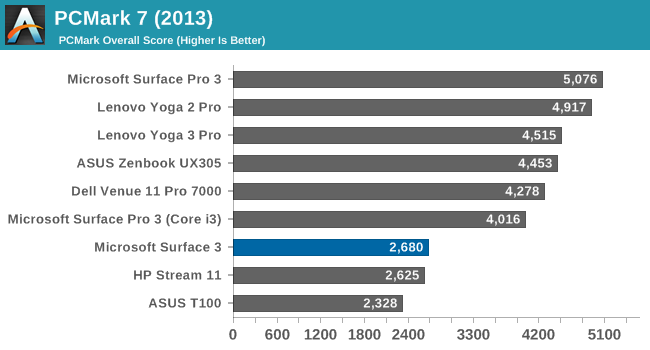
PCMark 8 from Futuremark has several benchmarks within it, all with the goal of simulating real-world use cases for each of the scenarios. It includes Home, Creative, Work, and Storage benchmarks. The workloads generally include both burst and sustained performance. The Atom can’t compete with the bigger Core pieces, but it is actually surprisingly close to the Core i3 Surface Pro 3. I think this is less about Atom and more about how handicapped Core i3 is with its lack of Turbo.
TouchXPRT


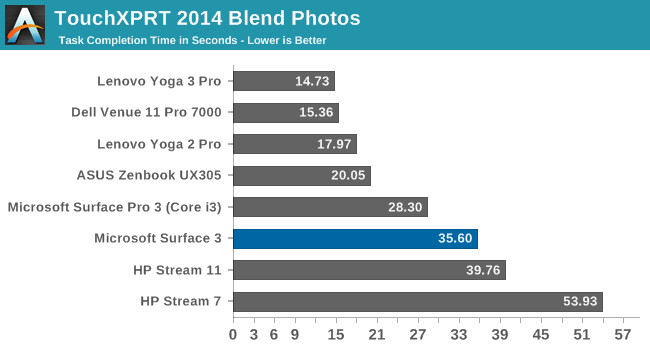
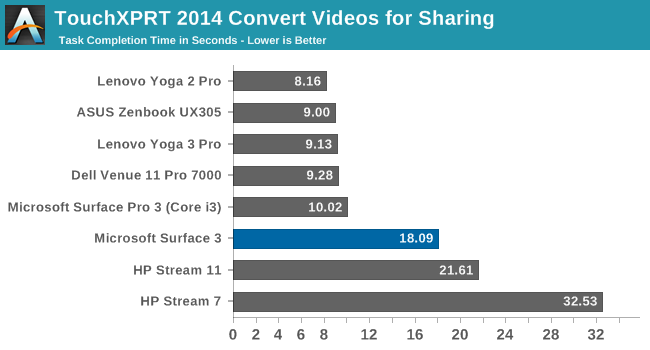
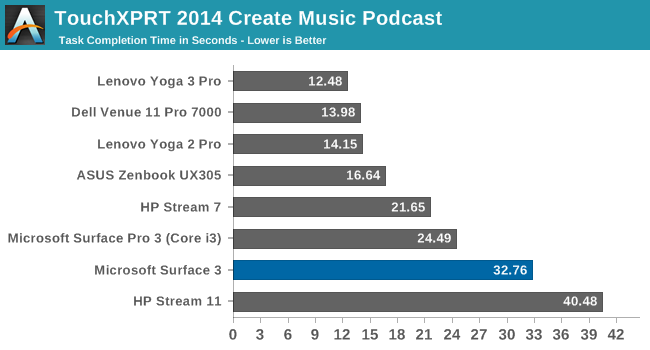
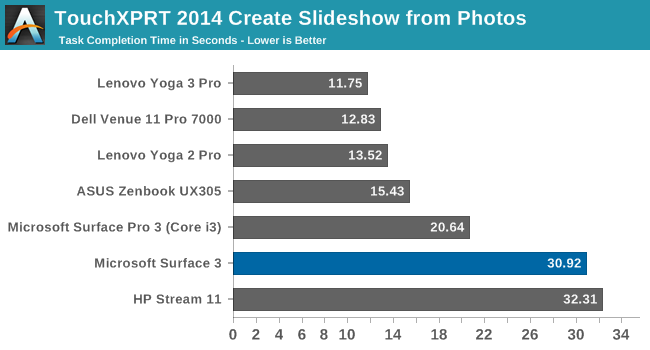
TouchXPRT 2014 is a benchmark that has a lot of burst workloads. The tasks are quick, but heavy, and it gives the processor a quick chance to cool off between each one so normally it is good about not running into throttling behaviour. The Atom processor is a long way off of the Core series here, with the exception of the i3 Surface Pro 3 which has no turbo capability. However there is a good bump in performance over the previous generation Atom in the HP Stream 7.
Cinebench

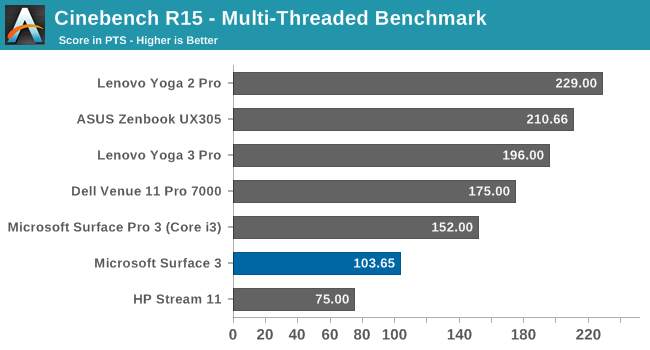
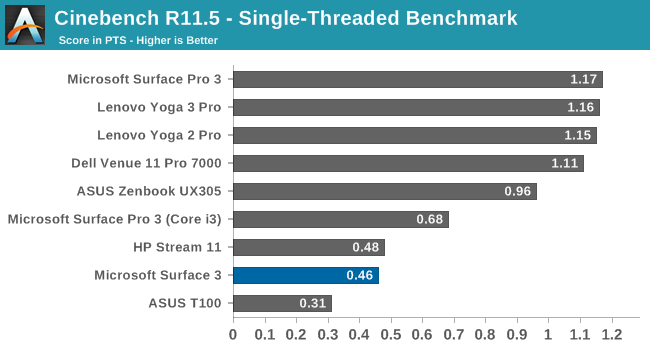
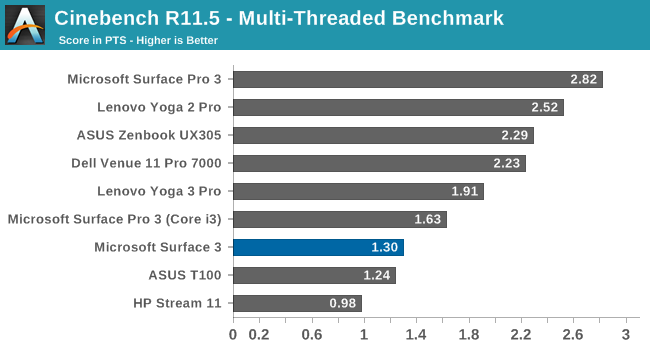
Cinebench is purely a CPU task, and it loves Instructions Per Clock (IPC) and frequency. There are two modes here with a single CPU run and all core run. It is still a long ways back of the Core i3 Surface Pro 3 on this test, and despite the Atom processor having four physical cores and the Core processors having only two physical and four logical cores, it is still not enough on the multithreaded run to really close the gap, although it does slightly. Looking at version 11.5 of this test, we have more data going back to older devices, so there are scores available from the ASUS T100 and there is a bump in performance compared to Bay Trail.
x264
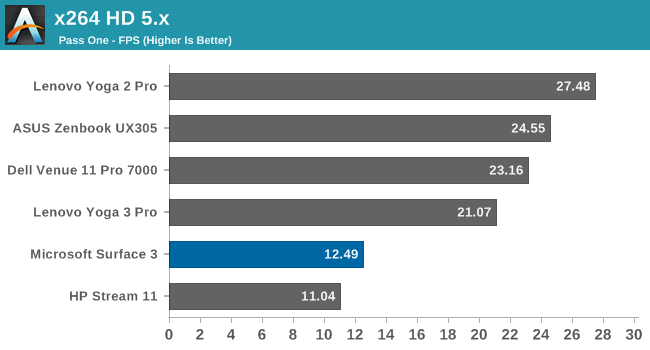

Once again this is a benchmark that prioritizes good IPC and frequency, along with multiple cores. The Atom struggles here compared to Core, which at this point should not be a surprise.
So clearly the new Cherry Trail CPU cores are not a giant leap in performance over Bay Trail, but like Haswell to Broadwell, there is a decent bump and the better manufacturing process helps increase overall performance due to the additional thermal headroom in the same power envelope. However when comparing it to the ARM competition, we only have a few data points but it does seem to be about on par with the top ARM CPUs at this time. Comparing devices across different operating systems is always difficult though.
Using the device day to day as a tablet though, performance was good. Yes, it could be better, and devices that use Core M are going to be able to run circles around Atom, but at the cost of additional heat. One of the nicest surprises of using this tablet was that it just never got warm at all, and the same cannot be said of any of the passively cooled Core M devices. Sure, when running very heavy benchmark loads, there was a bit of heat on the back, but it was never much more than around 30°C or so.
My experience was that when the Surface 3 felt slow, it was often not CPU bound but disk bound.










265 Comments
View All Comments
extide - Monday, May 4, 2015 - link
Yeah, but that is only sequential -- in random I/I the eMMC will still beat the pants off a regular laptop hdd -- and that's what really matters.lilmoe - Monday, May 4, 2015 - link
Wouldn't you think that random speed not only makes up for that, but also makes it seem much faster in real life scenarios compared with HDDs?Anyway, UFS should make the gap much wider in future products. Samsung and others are working on super cheap modules. SSDs aren't needed in most segments.
magreen - Monday, May 4, 2015 - link
Yes, it is better in random access than a cheap laptop HDD. But I don't know if that's the only thing that matters. It's unbalanced, just like the early SSDs were. The early SSDs were unreasonably slow in random write, and this is unreasonably slow in sequential write.As to which is more essential to feel "fast," I think that may be in the eye of the beholder. Yes, this eMMC may have some snappiness to it due to quickness in random access, so it won't get slowed to a clickety-clackety crawl by a virus check, for example. But it's probably painfully slow to complete tasks we're not accustomed to waiting for (sequential). That may be what the reviewer is pointing out, that storage seemed to be a bottleneck.
68k - Wednesday, May 6, 2015 - link
Mechanical HD and eMMC is not even at the same level when it comes to which feel "faster". Random access is far more important for everyday use, which make eMMC superior in very close to 100% of the use cases.Random access performance of small sizes at low queue depth is what a disk targeting interactive usage should optimize for.
magreen - Wednesday, May 6, 2015 - link
Really? For a full-blown Windows install? How would you know?You're not making a fair comparison. Remember this thing runs full Windows 8.1. The whole purpose is that people can use their standard desktop applications. You can't just think of the speedup from a typical HDD to a typical SSD. You'd have to cripple the sequential access to make the assessment.
When was the last time you used an external SSD over USB 2.0 as your boot and programs install drive, to test your hypothesis? Or how about a microSD card as your boot drive? How slow would it be to fire up Microsoft Word? How about opening up a large video file? What about a file copy? You're not used to waiting for the sequential aspects of any of those because they're almost always >100MB/s, even on a cheapo 5400 rpm HDD.
jabber - Tuesday, May 5, 2015 - link
33MBps but far far lower latency which I find more effective/noticable than raw MBps. The average user won't be overly concerned.Too many of us here have just been spoilt.
tim851 - Monday, May 4, 2015 - link
I don't know, man. Here in Germany the Surface 3 64 GB is 10% more expensive than the iPad Air 2 with 64 GB. And I would never call an iPad 'good value', though it will likely hold its value better than the Surface.The Surface has the perk of running full Windows, but without a keyboard, I don't see anybody getting much use out of the desktop.
I personally still find the S3 pretty enticing, if only for the Stylus, which is another Apple-priced add-on. But I would call it good value, not to speak of "best value".
lilmoe - Monday, May 4, 2015 - link
Ok, but how many tablets do you know can do what the Surface 3 can at that price?I do agree that the accessories are on the overpriced side, but don't forget that they aren't the only accessories that work with this device, and it doesn't *need* them to deliver on its promise. I personally wouldn't be using it as a "laptop replacement" on the go, but at home or in the office, I'd connect it to a bluetooth/wireless mouse/keyboard and an external monitor if necessary...
This device works great for any type of media consumption since it's capable of running/viewing just about anything. It's also great for Office at home, or for your average secretary, assistant, HR, and sales employee for work. It's one of a kind device for these purposes.
Manch - Monday, May 4, 2015 - link
I have an original PRO and I use onenote on it religiously. Its replaced paper notebooks for me. I'm actually thinking about getting the S3. The pen is awesome. Marking up docs is great. Hand writing rec even works on my writing and I write right handed now bc of an injury. whether I'm at a tech conference or just at work, the device is awesome. My buddy has the S3 Pro and I drool about getting one. Thing is I have the dock, keyboard and what not already so I'm reluctant to buy again. I dont however need the power I have in the PRO. The regular S3 would work great.Manch - Monday, May 4, 2015 - link
I forgot to add, I dont see the desktop much on the PRO. I use it in tablet mode. Keyboard only gets snapped to it when i'm on the road bc its more than enough computing power. At my desk when docked i have an external monitor and kb mouse. With Windows 10 on it now, wow, so much better!